Use 'Print preview' to check the number of pages and printer settings.
Print functionality varies between browsers.
Printable page generated Saturday, 22 November 2025, 3:22 PM
Using and understanding Internet services
1 What are Internet services?
- The Internet is a collection of interconnected computers, sharing data and services. A service is a program running on a computer that allows you to perform a useful activity such as:
- browsing the World Wide Web (WWW)
- sending and receiving email
- downloading video and music files
- communicating with friends and family using voice and video.
- Many of the services supported by the Internet operate as client/servers. This allows one device (server) to provide a service to a requesting device (client):

- In many smaller networks, devices operate as peers. This is where devices can behave as either client or server, depending on which services they are using. This operation is referred to as peer-to-peer, and is commonly found in home networks as it is easily configured. The mode of operation is difficult to use within larger networks, but it is often used within Internet-based file sharing services.
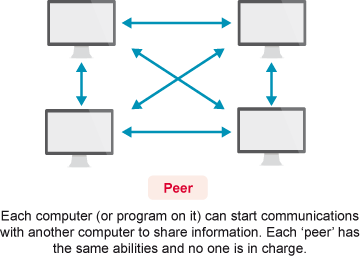
2 The WWW as a service
- The WWW operates using clients and servers. Web pages are stored on servers connected to the Internet, and your PC uses a web browser acting as a client to access pages stored on the servers:

- Watch this video on web services to find out more:
3 The WWW and web crawlers
- The WWW consist of an extremely large collection of web pages (more than 4 billion in 2017) stored at more than a billion websites. You can view the current numbers here.
- Because of the speed at which websites are being added to the WWW, finding sites you are interested in can be quite a challenge. You have probably used a search engine to find web pages, but how do they know about all the new websites continually being added to the WWW?
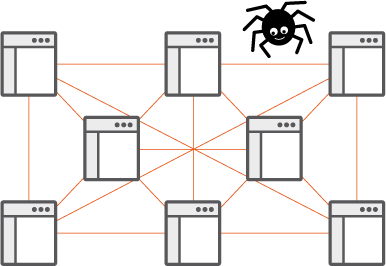
- Search engines use special computer programs called web crawlers to automatically learn about new content when it is added to the WWW.
- Web crawlers browse the WWW in a methodical manner, copying web page content, including Uniform Resource Locators (URLs) linking to other web pages and sending it to the search engine. This information is then processed by the search engine, which stores key words and information in such a way it can be accurately searched by web users. This processing of web page information collected by web crawlers is called indexing.
- The URLs used by web crawlers provide a unique identity for each web page, and indicate where it is stored:

- When a web crawler is started, it is provided with a list of URLs (called seeds), which it then visits. It collects all the URLs of hyperlinks it finds at these sites. These are then added to the list of sites for the web crawler to visit, providing an expanding set of pages to search and copy:

- Due to the size of the WWW, and the rate at which it grows, web crawlers are not able to search all the pages in existence while also checking known pages for updates. Even large search engines like Google have not indexed the entire WWW.
4 The WWW and search engines
- When you try to find a web page using a search engine, the search engine looks through the index of the pages created by the web crawler.
- The search engine will examine the search term and compare it against the index of information it holds for:
- how often the search words occur on a page
- where they are on a page
- if they occur together
- if there are similar words.
- It uses this information to choose web pages that it considers to best meet your search request. The pages are then displayed in order, with the ones meeting the search term best being shown at the top.
- Some search engines (e.g. Google) use the concept of rank when presenting search results. This considers the amount of links on other relevant websites pointing towards a particular page. The more links from related web pages, the higher the ranking.
- Search engines accept payments from commercial organisations to place their web pages higher up the displayed list from a given search, even if their page is not a particularly good match.
- This is a form of advertising, and the search result will be marked with ‘Ad’ to indicate this:

- To learn more, take a look at the following videos:
- Matt Cutts’s video on ‘How Search Works’.
- Google’s video, ‘Verbatim and double quotes’, on search terms.
Activity: WWW searches
Demonstrate that you can perform WWW searches by carrying out some research into one of the following topics:
- Geography: The Earth is a diverse planet, and is home to many species of animals, many of which are endangered. Identify an endangered animal from each of the Earth’s continents:
| Asia | |
| Africa | |
| North America | |
| South America | |
| Antarctica | |
| Europe | |
| Australia |
5 Email
- Electronic mail or email provides a way of exchanging digital messages across computer networks. The messages can consist of just simple text, but you can also attach a variety of different files (e.g. documents, pictures, videos).
- Email works as a client/server service, and allows you to create emails using client software (e.g. Outlook, Thunderbird) which then transfers the emails to mail servers where they are stored until retrieved by the email recipient. This means you only need to connect briefly to the Internet to send and receive emails.
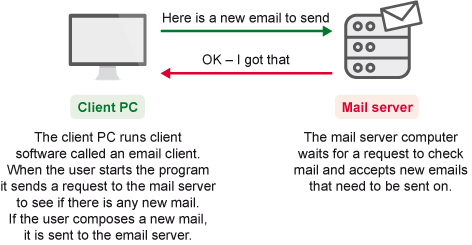
- To use email, you need an email address, which uniquely identifies a user with an account on a particular mail server. The address consists of a local part, identifying the user’s mailbox, and a domain name which identifies the mail server location:
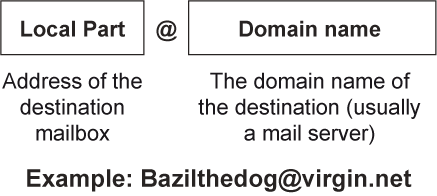
- Many email services are now web based, so you can write, send and receive email via a web browser after you have set up an account with an online email provider, such as Google or Yahoo!
- Take a look at this video for more information about email.
6 File transfer
- There are many different services available allowing the transfer of files across a network. Most computer operating systems (e.g. Windows, Linux) allow you to set up a peer-to-peer network at home so you can share files and other resources, such as Internet access and printers.
- These services may not work correctly if you have devices using different operating systems, so file transfer protocols need to be capable of working regardless of the operating system you are using:
- Server Message Block (SMB) allows the sharing of files and printers within a Local Area Network. Although it was originally supported by just Microsoft operating systems, it is now supported by Apple and Linux operating systems too. It operates as a peer-to-peer service.
- File Transfer Protocol (FTP) provides a client/server service for transferring files across the Internet. It is supported by a wide range of different operating systems, and is also built-in to many software programs supporting file transfer.
7 Report concerns
- The Internet provides many useful and entertaining services, but due to its global nature, it is very difficult to regulate. This means, as well as many legal uses, the Internet can also be used to support illegal activities.
- If you have concerns about something you have seen on the Internet, there are a variety of organisations that you can turn to:
National Crime Agency’s Child Exploitation and Online Protection Centre

If you or a friend are suspicious about the way someone you have met online is behaving towards you, or they are asking you to do things that you feel uncomfortable with, report it to the Child Exploitation and Online Protection Agency (CEOP).
This often starts with meeting some online and not really knowing who they are. If you feel uncomfortable get out and report it.
Internet Watch Foundation

You should report any material you find online to the Internet Watch Foundation (IWF) that shows:
- pictures of children being sexually abused
- criminal obscene pictures.
Parent Port
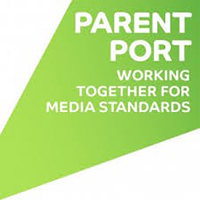
You can report any concerns you or your parents have over what you see and hear in the media to Parent Port. This includes content on the Internet, such as:
- a movie, game or advert that makes you feel upset, or is unsuitable for your age group
- any other material online that is not suitable for your age and makes you feel surprised it is there.
True Vision

If you find people being horrible online and trying to get you or groups of people to be horrible to others because of their religion, sex or where they come from, this may be a hate crime and is a criminal offense. You can report it to True Vision.
- Watch the online video about Digital Safety, Responsibility and Awareness to learn more about staying safe on the Internet.
8 Activities
Individual Activities
- Complete the KidSMART Treasure Hunt worksheet.
- Play the Digital Citizen game.
Activity for the whole class: Web and email services (Packet Tracer)
The Internet is made up of computers connected together in groups. These groups are also all connected together. But the Internet also includes computers connected at home to Internet Service Providers. In addition, when we are out and about we can connect our smart devices over 3G and 4G networks to the Internet.
How does all this connectivity work? Explore web and email services for Bob and Ann using Packet Tracer and the Blue Lab Book.
You will need:
9 Additional resources
For more information, take a look at the following resources.
- BBC Bitesize - How Do Search Engines Work
- BBC Bitesize - Believing everything on the web
- BBC Bitesize - Communicating Online
- Searching Google - A detailed document called ‘Google Guide’, describing lots of ways to search using the power of Google
- How Stuff Works Search Engines
10 End of course quiz
Now it’s time to test what you’ve learned in a quiz.
11 Acknowledgements
Grateful acknowledgement is made to the following sources:
Figure 1: Adapted from a Cisco Image
Figure 2: Adapted from a Cisco Image
Figure 3: Adapted from a Cisco Image
Figure 4: Adapted from a Cisco Image
Figure 5: Adapted from a Cisco Image
Figure 6: Adapted from a Cisco Image
Figure 8: Adapted from a Cisco Image
Figure 9: Adapted from a Cisco Image
Figure 10: Child Exploitation and Online Protection Agency (CEOP)
Figure 11: Internet Watch Foundation
Figure 12: Parent Port
Figure 13: True Vision
Every effort has been made to contact copyright holders. If any have been inadvertently overlooked the publishers will be pleased to make the necessary arrangements at the first opportunity.